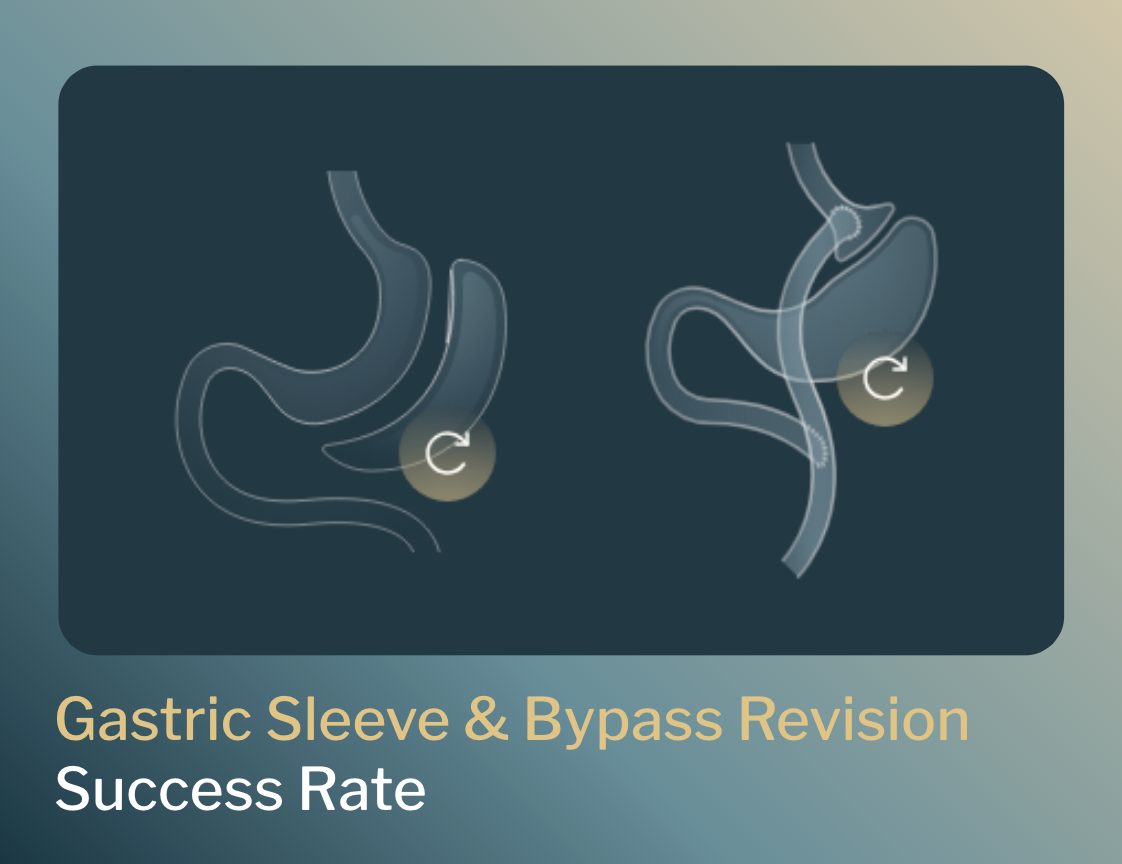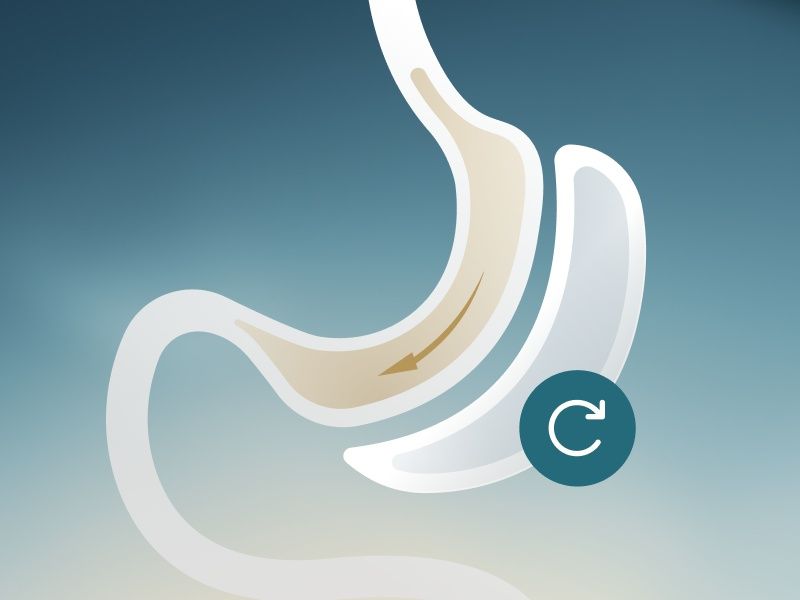Understanding Gastric Sleeve & Bypass Revision Success Rates
Understand gastric bypass and gastric sleeve revision success rates. Explore the expected outcomes of bariatric revision procedures for sustained weight loss.

Bariendo Team
Team @ Bariendo
Are you struggling with weight regain after bariatric surgery? Gastric bypass and gastric sleeve revision procedures can provide the reset you need for sustainable weight loss. These procedures are designed for patients who’ve struggled to maintain results after their initial surgery.
Below, we’ll explore gastric bypass and gastric sleeve revision success rates, expected outcomes, and the long-term benefits they provide. From surgical revisions to non-invasive endoscopy revision procedures, you’ll gain a clear picture of the options available and how they can help you achieve your goals.
Gastric Sleeve Revision Success Rates
Studies show that up to 76% of patients experience significant weight regain within six years of gastric sleeve (sleeve gastrectomy) surgery. While weight regain is the most common reason for gastric sleeve revision, side effects like severe acid reflux can also be a contributing factor.
Let’s explore the options available for gastric sleeve revision and what their success rates look like, so you know what to expect moving forward.
Endoscopic Gastric Sleeve Revision
Endoscopic gastric sleeve revision, called Sleeve-In-Sleeve (SIS), has a high success rate, with 82% percent of patients losing at least 10% of their body weight and achieving an average of 15% weight loss. This non-invasive, scar-free procedure is designed to re-tighten the stomach to its original restrictive size.
The SIS procedure takes only 30-45 minutes to complete, patients can go home the same day, and return to their normal routine, including exercise, in just a few days. Since there’s no external incision, patients experience less pain, fewer risks, and a faster recovery, making SIS ideal for those who want a safe, effective solution with minimal downtime.
Surgical Gastric Sleeve Revision
The typical success rate with surgical gastric sleeve revision ranges from 60-70%, with many patients achieving meaningful weight loss. During this surgery, the stomach is resized to restore its original restricted capacity.
Recovery after surgical gastric sleeve revision is similar to the original procedure. It requires a short hospital stay, time off work, and at least a month of recovery before returning to exercise. This lengthy recovery period prompts many patients to explore less invasive alternatives first.
Conversion to Gastric Bypass
Approximately 20-30% of patients who undergo gastric sleeve surgery experience severe acid reflux or GERD. Over time, acid reflux can lead to esophageal cancer. For patients whose acid reflux can’t be controlled with medication, a conversion to gastric bypass is often recommended.
During this procedure, a small pouch is created from the stomach and the digestive tract is rerouted, which reduces stomach acid production and enhances weight loss by limiting food absorption. Studies indicate a high success rate, with patients achieving an average excess weight loss of 41.5% after one year. However, this procedure requires a long recovery period and comes with more potential risks.
Gastric Bypass Revision Success Rates
Patients who have undergone gastric bypass sometimes experience weight regain over time. Gastric bypass revisions are designed to restore weight loss progress and improve overall health outcomes. Let’s explore gastric bypass revision success rates and what patients can expect from these procedures.
Endoscopic Gastric Bypass Revision
Endoscopic gastric bypass revision, known as Transoral Outlet Reduction (TORe), is a non-surgical procedure designed to address weight regain after gastric bypass. Purse-string TORe, an advanced endoscopic procedure offered at all Bariendo locations, results in an average of 10% weight loss.
Patients who are looking for even more dramatic results may wish to explore the non-invasive Purse-string TORe+ procedure, which results in 12-15% weight loss without the need for surgery. These procedures offer safe and effective solutions for patients who want to regain control of their weight and related health conditions without the risks and extended recovery times of surgical revision.
Surgical Gastric Bypass Revision
On average, patients can achieve 12-15% weight loss in 1 year after surgical gastric bypass revision. This approach may involve resizing the stomach pouch, altering the connection to the small intestine, or repairing anatomical issues that may have developed over time.
The surgery is invasive and requires a short hospital stay, extended recovery period, and significant downtime before return to work and exercise. While this approach can lead to meaningful outcomes, it comes with a higher risk of complications compared to non-surgical options like TORe.
Wondering if you meet the requirements for endoscopic gastric bypass or gastric sleeve revision? Take this two minute quiz to learn more and find the best path to healthy weight loss.
Factors That Influence Success Rate After Bariatric Revision
The success rate of gastric bypass or gastric sleeve revision does not rely solely on the procedure itself. A variety of factors play a role in how effective your revision will be, and understanding these elements will help you maximize your long-term results.
Post-Surgical Lifestyle Changes
Revision procedures are powerful tools for getting back on track, but they work best when paired with a healthy lifestyle. Following a nutrient-dense, portion controlled diet that supports long-term weight management is crucial for success.
Regular physical activity is also a key component. Patients who incorporate regular exercise, such as walking, resistance training, and other activities they enjoy, are more likely to achieve a healthy weight and maintain their weight loss over time.
Patient Health and BMI
Overall patient health and BMI can play a role in bariatric revision success rates. In some cases, patients with a lower BMI experience better outcomes because their bodies are under less stress during recovery and may be more responsive to the procedure.
Pre-existing health conditions, such as diabetes, hypertension, or mobility issues, can also impact weight loss success. Managing these conditions with the help of your healthcare provider, both before and after the procedure, is essential for maximizing results.
Time Interval Since Initial Surgery
Patients who undergo a revisional procedure within two to three years after their initial surgery often achieve better outcomes. This may be because weight regain isn’t as severe or the stomach hasn’t stretched as much.
Things like scar tissue, advanced weight regain, and severe stomach stretching may affect results for patients who wait longer before seeking a revision. However, even with a longer interval, most patients still achieve meaningful weight loss and health improvements with the right procedure.
Follow Up Care and Support
Patients who actively participate in follow-up care and work closely with their healthcare team often achieve the most successful outcomes. This includes attending nutrition counseling, tracking food intake, and addressing behavioral challenges that may be contributing to weight regain.
Having a strong support system also plays a vital role. Having family, friends, or a support group to encourage and motivate you can make a significant difference in your journey. Bariendo emphasizes personalized follow up care and offers patients the tools and guidance they need to achieve lasting results.
Measuring Success after Gastric Sleeve or Gastric Bypass Revision
Success after bariatric revision goes beyond numbers on a scale. While weight loss is an important goal, there are other factors that define the true success of your weight loss journey.
Sustainable Weight Loss
Achieving sustainable weight loss means achieving a healthy weight and keeping it off long term. Revision procedures play a key role in achieving sustainable weight loss when paired with an ongoing commitment to healthy habits.
Bariendo’s advanced endoscopic procedures, including Sleeve-In-Sleeve (SIS) gastric sleeve revision and Purse-String TORe gastric bypass revision, have been shown to deliver long-term success with minimal downtime. Their long term effectiveness, combined with Bariendo’s emphasis on follow-up care and personalized support, make endoscopic revision procedures an excellent choice for achieving sustainable weight loss.
Improvement in Obesity-Related Comorbidities
For patients struggling with weight related health conditions like type 2 diabetes, hypertension, or sleep apnea, the benefits of a successful revision go far beyond weight loss.
Symptoms related to diabetes often improve as patients lose weight adopt healthier lifestyle habits. Lower blood pressure, improved cholesterol levels, and better control of blood sugar are also common. These improvements help patients lead healthier, more active lives and may even increase longevity.
Improved Quality of Life
Many patients report increased energy levels, enhanced mobility, and greater confidence in their daily lives after a successful bariatric revision procedure. These changes make it easier to participate in daily activities that they once found challenging, such as traveling or playing with their children.
Improved mental health is another significant benefit, especially for patients who have been frustrated or discouraged by weight regain after bariatric surgery. Achieving meaningful weight loss after a revision procedure brings a renewed sense of hope and accomplishment.
Revive Your Weight Loss Journey
Weight regain after bariatric surgery can be discouraging, but non-surgical revision procedures like SIS and TORe offer a proven path to reclaim your progress and achieve lasting results. These procedures deliver meaningful, long-term weight loss with minimal disruption to daily life.
At Bariendo, our patient-first approach ensures that you’ll receive personalized care and the support you need to succeed. Ready to revive your weight loss journey? Schedule a free consultation to learn how our innovative procedures can help you achieve your goals.

